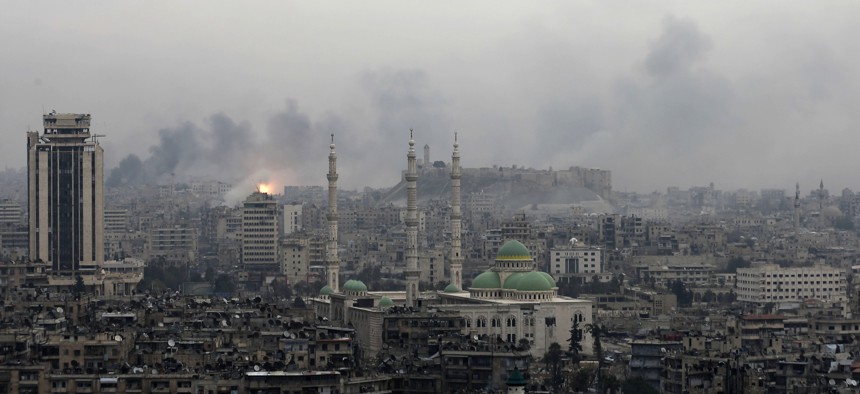
A ball of fire rises following a Syrian government air strike that hit rebel positions in the eastern neighborhoods of Aleppo, Syria, Monday, Dec. 5, 2016. Hassan Ammar/AP
A Dictator Among the Ruins: What Comes Next in Syria
Putin and Assad’s victory in Aleppo will usher in a new phase of the conflict, rather than its end.
“All the world has failed us,” a resident of the Syrian city of Aleppo told the BBC this week, via a WhatsApp audio message. “The city is dying. Rapidly by bombardment, and slowly by hunger and fear of the advance of the Assad regime.”
In recent weeks, the Syrian military, backed by Russian air power and Iran-affiliated militias, has swiftly retaken most of eastern Aleppo, the last major urban stronghold of rebel forces in Syria. Tens of thousands of besieged civilians are struggling to survive and escape the fighting, amid talk of a rebel retreat. One of the oldest continuously inhabited cities on earth, the city of the Silk Road and the Great Mosque, of muwashshah and kibbeh with quince, of the White Helmets and Omran Daqneesh, is poised to fall to Bashar al-Assad and his benefactors in Moscow and Tehran, after a savage four-year stalemate. Syria’s president, who has overseen a war that has left hundreds of thousands of his compatriots dead, will inherit a city robbed of its human potential and reduced to rubble.
This is a story of the influence foreign powers can have on civil wars; Assad would not be winning without the support of Iran and particularly Russia, which launched its military intervention in Syria a year ago. But it’s also a story of what happens when foreign powers choose not to exercise their influence in civil wars. The Obama administration has been gradually withdrawing military aid to what it considers moderate rebel factions in Syria, some of which are currently losing ground in Aleppo. Donald Trump will probably cut off all U.S. assistance to these groups as part of his effort to partner with Russia in the fight against terrorism. More reliable sponsors of Syrian opposition forces, like Turkey, Saudi Arabia, and Qatar, haven’t come to the rebels’ rescue to the extent that Russia and Iran have to Assad’s. The United States is concentrated on ISIS elsewhere in the country, the Gulf countries distracted by their war in Yemen, Turkey focused on its fight with ISIS and Syrian Kurdish militias. Aleppo’s rebels are, essentially, on their own.
If Assad reclaims Aleppo, he will achieve his most significant victory yet in Syria’s long war—a victory that would also belong to Vladimir Putin and the leaders of Iran. Still, the fall of Aleppo would likely usher in a new phase of the conflict rather than end it altogether. As Andrew Tabler of the Washington Institute for Near East Policy explained to Kathy Gilsinan earlier this year, Assad would then control all of Syria’s major cities—Aleppo, Damascus, Homs, and Hama—and thus “essential Syria.” This would allow him and his allies to go on the offensive in other parts of the country like Idlib province, just southwest of Aleppo, where Syria and Russia have been funneling rebel forces defeated elsewhere in the country. (The Russian strategy is simple, an anonymous European diplomat toldReuters this week: “Place them all in Idlib and then they have all their rotten eggs in one basket,” for Russian warplanes to target.) Eventually, perhaps months or even years later, Assad’s coalition could turn its attention to ISIS. In this scenario, an internationally brokered peace agreement would presumably be on terms favorable to Assad.
During this next phase, some analysts predict, the rebel resistance could morph into more of a guerrilla force—a rural Sunni insurgency battling Assad, Russia, and their Shia allies. Rebel fighters from Aleppo could join the Turkish-led offensive against ISIS near Turkey’s border with Syria, or merge with extremist Islamist groups battling Assad from Idlib. But ultimately, the opposition’s future looks bleak. “Though many [rebels] have sworn to continue fighting, some are likely to conclude that without Aleppo and with Donald Trump in the White House, there is no longer any hope of achieving a victory over Assad,” the Syria researcher Aron Lund wrote recently.
The fall of Aleppo and the triumph of Putin and Assad would also serve as a reminder that the Syrian Civil War is a symptom as well as a cause of tremendous flux in the region. In a recent study of foreign involvement in the conflict, Christopher Phillips, a Syria expert at Queen Mary University of London, notes that the 2011 Syrian uprising, and subsequent war, erupted just as America’s post-Cold War dominance in the Middle East was fraying, as a result of the “failures of the 2003-11 occupation of Iraq, the decreasing importance of Gulf oil, [and] economic and military retrenchment following the 2008 financial crisis and the election of Barack Obama who criticized his predecessor’s military adventures.” During this same period, some regional players (Iran, Turkey, the Gulf states) have become more active in the Middle East, while others (Iraq, Syria) have devolved into “prizes” for other powers to compete over. Russia, meanwhile, has reengaged with the region after a lengthy absence.
The United States, Phillips writes, “is still the most powerful actor” in the Middle East, but “it no longer enjoys the perceived hegemony of the 1990s and 2000s, and regional actors and Russia have vied to increase their influence. … [T]he years before and after 2011 have witnessed each actor, including the US, probing what is possible” in this new environment. This probing has had dangerous consequences. “Saudi Arabia, Qatar and Turkey in particular pushed headlong into encouraging a conflict in Syria they could not end without American assistance,” Phillips argues. “Russia and Iran, while more adept, proved unable to moderate their ally Assad’s behaviour, but their geopolitical agendas locked them into his camp even so.”
A new system has yet to replace the old one in the Middle East. This transitional moment did not produce the Syrian Civil War. But it helps explain why that war is now a hellish kaleidoscope of conflicts, and why it may end with a murderous dictator ruling a country in ruins.
NEXT STORY: ‘Trump Has Already Created Lots of Chaos’




